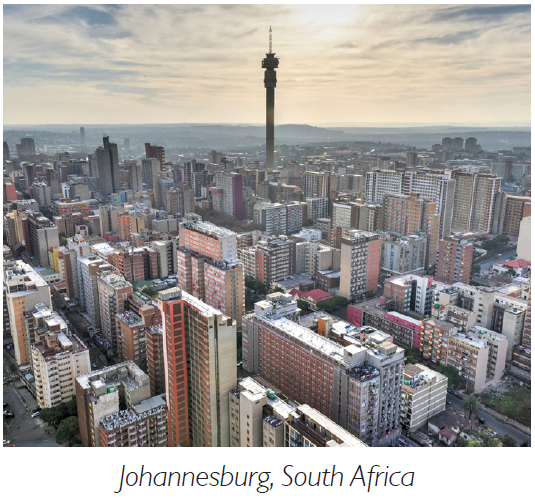Borrower Overview
TriLinc has provided financing to an industrial materials distributor in South Africa. Established in 2008, the borrower provides transportation, logistics services, and supply chain solutions for customers engaged in various industries throughout the greater Sub-Saharan Africa region. Secured by specific product inventory, TriLinc’s financing provides the borrower with timely and flexible short-term liquidity to import and distribute critical raw material to customers operating in the region’s metal processing industries. The borrower anticipates that in addition to ensuring the timely delivery of goods to market, TriLinc’s financing will further its business expansion and ultimately support its efforts in expanding its employee base.
Market Overview

South Africa is classified as an upper-middle income country by the World Bank.1 South Africa is distinguished as the only African member of the G20, an international council for the major economies’ finance ministers and central bank governors to discuss financial and monetary policies, with the goal of promoting world economic development.2 Between 2010 and 2014, annual GDP growth rates averaged approximately 2.4%.1 South Africa’s main exports have traditionally been concentrated in gold, diamonds, platinum, other metals and minerals, and machinery and equipment.3 Conversely, the country’s main imports have been focused in machinery and equipment, chemicals, petroleum products, scientific instruments, and foodstuffs.3
South Africa meets TriLinc’s country standards for its performance across relvant growth, stability and access metrics.4 In 2014, it ranked 3rd across the Sub-Saharan Africa region on the World Bank’s Ease of Doing Business Index.5 In relation to the borrower, South Africa is ranked highest on the continent for its transport infrastructure, according to the World Economic Forum’s Global Competitiveness Index.6 As the second largest economy in Sub-Saharan Africa,7 the country benefitted from the $37 billion in net foreign direct investment that was estimated to have flowed into the region in 2014.13 Robust domestic demand across Sub-Saharan Africa helped spur GDP growth to 4.6% in 2014.8 Looking ahead, overall regional GDP growth is projected to strengthen to 5% by 2017.9
Additional Sustainability & Impact Highlights
- The borrower is a signatory to the Responsible Care Initiative, a global program which envisages a profitable, sustainable chemical industry and whose signatories seek to conduct their operations in a manner that minimizes adverse environmental impacts and protects the health and safety of their employees, contractors, and the public.
- The borrower is registered and independently-certified as a Black Economic Empowerment Enterprise under the Government of South Africa’s Broad-Based Black Economic Empowerment initiative, and seeks to grow its business and employee base in a fair and equitable manner.
- Conscious of the environmental impact of its administrative operations, the borrower participates in weekly waste recycling through a program offered by Mpact Limited, South Africa’s largest paper recycler.
- As a responsible corporate citizen, the borrower provides financial support to the Save the Rhino Fund and is in the process of setting up a local program to finance the education of underprivileged students.
1The World Bank, World Development Indicators Database, South Africa, 2015. 2G20, 2015. 3CIA, The World Factbook, 2015: South Africa. 4There is no assurance that our investment in this company or this market will be successful. 5World Bank, Doing Business 2014 Understanding Regulations for Small and Medium-Size Enterprises 6World Economic Forum, The Global Competitiveness Report 2015-2016. 7The World Bank, World Development Indicators Database, 2015. 8The World Bank, Data, Sub-Saharan Africa, 2015. 9The World Bank, Global Economic Prospects, June 2015. 10The World Bank, Global Economic Prospects, June 2015.
The above information is as of the initial date of investment: November 20, 2014.
This borrower is no longer a TriLinc fund investment.
TriLinc originally performed an SDG mapping exercise in December 2017 to map all of our borrower companies, both current and exited from our portfolios, to specific SDGs based off of business activity. TriLinc’s official SDG alignment methodology was not finalized until June 30, 2018. For borrowers that had exited TriLinc’s portfolios prior to this time period, the selected SDGs for these borrower are a reflection of what TriLinc believes would have been the SDG alignment if 1) the SDGs had been in effect and 2) TriLinc had integrated the SDG alignment while the company was in the portfolio. The SDG mapping presented does not include input from Investment Partners or borrower companies given that the companies were no longer in the portfolio when the alignment was finalized.
An investment with TriLinc carries significant fees and charges that will have an impact on investment returns. Information regarding the terms of the investment is available by contacting TriLinc. This is a speculative security and, as such, involves a high degree of risk. Investments are not bank guaranteed, not FDIC insured and may lose value or total value. Some investments may have been made in an investment vehicle that is no longer open for investment. The highlighted investment may or may not have been profitable. There is no guarantee that future investments will be similar.
Want to learn more? Contact Us.
